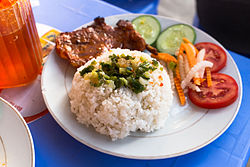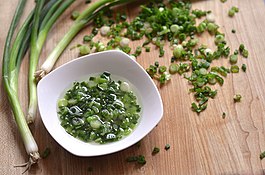Cơm tấm

 Cơm tấm served with grilled pork and fish sauce. | |
| Alternative names | Cơm sườn |
|---|---|
| Course | Breakfast Lunch Dinner |
| Place of origin | Vietnam |
| Region or state | Southern Vietnam |
| Main ingredients | Broken rice, grilled rib, fish sauce with sugar, pickled carrots, oil garnish |
Cơm tấm (Vietnamese: [kəːm tə̌m]) is a Vietnamese dish made from rice with fractured rice grains. Tấm refers to the broken rice grains, while cơm refers to cooked rice.[1][2] Although there are varied names like cơm tấm Sài Gòn (Saigonese broken rice), particularly for Saigon,[1] the main ingredients remain the same for most cases.
History
[edit]In its early days, Com Tam was a popular dish among poor rice farmers in the Mekong Delta due to their economic circumstances.[3] During bad rice seasons, these people did not have enough good rice to sell, so they used broken rice to cook. Broken rice is fragments of rice grains broken during the handling processes and was regarded as inferior rice at the time.[4] Broken rice was used solely because it was readily available in the farmers' houses and could fill their stomachs for a long time.[3]
Since Vietnam's urbanization in the first half of the 20th century, Com Tam became popular across Southern provinces, including Saigon.[5][4][6] When Saigon was bustling with many people from many countries around the world, food sellers adapted Com Tam to be more suitable for foreign customers like the French, American, Chinese, and Indian. As a result, grilled pork, chả trứng (Vietnamese-style steamed omelet with pork) was added to Com Tam. Also, the portion started being served on plates with a fork instead of in traditional bowls with chopsticks.[3][7] Nowadays, Com Tam is popular among everyone, and is a "standardized part of the [Saigon] culture",[5][6] so much that there is a common metaphorical saying (translated from Vietnamese): "Saigon people eat Com Tam like Ha Noi people eat Pho".[8][9][10]

Ingredients
[edit]Although there are many variations of Com Tam that have different ingredients and styles, a popular, featured Com Tam dish commonly known as "Cơm Tấm Sườn Bì Chả" has the following ingredients:[11][12][13][14][7][15]
- Broken Rice – a traditionally cheaper grade of rice produced by damage in milling.[4][14] It is mainly used as a food industry ingredient in America and Europe, but in West Africa and Southeast Asia is used for direct human consumption.[4] Broken rice is fragmented, not defective; there is nothing wrong with it.[16] This is the main ingredient of Com Tam.
- Sườn nướng – Grilled pork ribs
- Bì – thin strands of pork and cooked pork skin seasoned with roast rice powder
- Chả trứng – Vietnamese-style steamed omelet with meatloaf. Nowadays this may be substituted with an omelet or fried egg[17]
- Scallion and oil garnish – chopped scallion lightly fried in heated oil until softened (serve both scallion and oil)[18]
- Various vegetables, such as sliced cucumber and tomato, and pickled vegetables such as carrot and radish pickles
- Mixed fish sauce (Nước mắm pha) – a sweet, sour, salty, savory or spicy sauce served in a small bowl beside the Com Tam dish. This ingredient is commonly considered an important part of a Com Tam dish[6][11]
Serving
[edit]Although chopsticks are commonly used by Vietnamese, Com Tam are enjoyed with a fork and spoon; and although the mixed fish sauce is commonly used for dipping in other Vietnamese dishes, for Com Tam, the sauce is for spreading onto the dish as needed.[19][20]
Honors
[edit]Com Tam is one of 10 Vietnamese dishes recognized by the Asia Record Organisation (ARO) for their important culinary value to the international community.[21]
See also
[edit]- Broken rice
- Bánh mì
- List of Vietnamese culinary specialities
- List of Vietnamese dishes
- Vietnamese cuisine
References
[edit]- ^ a b Thanh Nien Hot Spots 5 Jan 2012 "With your craftsmanship in hand, return to Saigon for a master class in clay-pot cooking, crafting cơm tấm (broken rice), caramelized pork belly,"
- ^ Freeman, Meera (2002). The flavours of Vietnam. Nhân, Lê Văn. Melbourne, Victoria, Australia: Black Inc. ISBN 1-86395-283-7. OCLC 55104782.
- ^ a b c Son, Nam (2000). Đất Gia Định - Bến Nghé Xưa & Người Sài Gòn. Ho Chi Minh City: Tre Publishing House. ISBN 978-604-1-12851-4.
- ^ a b c d "How Broken Rice Went From Poor to Popular". OZY. 2019-09-13. Retrieved 2020-05-06.
- ^ a b Marton, Renee (15 September 2014). Rice : a global history. London. ISBN 978-1-78023-412-0. OCLC 914328434.
{{cite book}}: CS1 maint: location missing publisher (link) - ^ a b c "Saigon's Classic: Broken Rice". i Tour Vietnam. Retrieved 2020-05-18.
- ^ a b "Nghề Bếp Á Âu". Nghề Bếp Á Âu (in Vietnamese). 2017-07-19. Retrieved 2020-05-06.
- ^ VCCorp.vn (2018-04-26). "Hít hà mùi thơm hấp dẫn của những quán cơm tấm lâu đời ở Sài Gòn". kenh14.vn (in Vietnamese). Retrieved 2020-05-06.
- ^ "Điểm danh 7 món ăn đặc sản Sài Gòn bạn nhất định phải thử một lần trong đời". Phụ nữ sức khỏe (in Vietnamese). Retrieved 2020-05-06.
- ^ Trí, Dân (2 January 2015). "Cơm tấm Sài Gòn". Báo điện tử Dân Trí (in Vietnamese). Retrieved 2020-05-06.
- ^ a b "What is broken rice? Here 's What you should Know !!!". YummY Vietnam. 2019-04-25. Retrieved 2020-05-07.
- ^ adminict (2015-03-02). "Com Tam – Traditional Vietnamese Broken Rice Food". Vietnam Culinary Travel Agency: Vietnam Food Tour Packages. Retrieved 2020-05-07.
- ^ Cook, Karla (2003-11-23). "RESTAURANTS; Benefits of Vietnamese". The New York Times. ISSN 0362-4331. Retrieved 2020-05-18.
- ^ a b "Broken Rice – What Is It?". runawayrice.com. 19 August 2018. Retrieved 2020-05-18.
- ^ City, Vinh Dao in Ho Chi Minh (2014-10-30). "Real street food – No 3: Com Tam, broken rice from Ho Chi Minh City". the Guardian. Retrieved 2020-05-18.
- ^ ars.usda.gov Agriculture Research, May 2002
- ^ Nancie McDermott Quick and Easy Vietnamese 2012 "OMELET WITH BEAN THREAD NOODLES AND PORK - chatrung - Order com tam bi in a Vietnamese café serving rice dishes, and you'll get a fabulous feast of rice along with shredded pork, peppery pork chops, and a chunk of this tasty omelet, which is called cha trung when it is served by itself..."
- ^ "Vietnamese Scallions & Oil Garnish Recipe (Mỡ Hành)". Hungry Huy. 2012-12-03. Retrieved 2020-05-18.
- ^ Pulido, Izzy (2019-04-06). "Saigon Street Food: Broken Rice (Com Tam)". Cmego Travel Guide. Archived from the original on 2020-10-24. Retrieved 2020-05-18.
- ^ VCCorp.vn (2018-08-10). "Không chỉ có phở mà đặc sản cơm tấm Việt Nam cũng được đài truyền hình nước ngoài ca ngợi hết lời". kenh14.vn (in Vietnamese). Retrieved 2020-05-18.
- ^ "Top ten Vietnamese dishes win Asian records". VOV - VOV Online Newspaper. 2012-08-05. Retrieved 2020-04-28.


